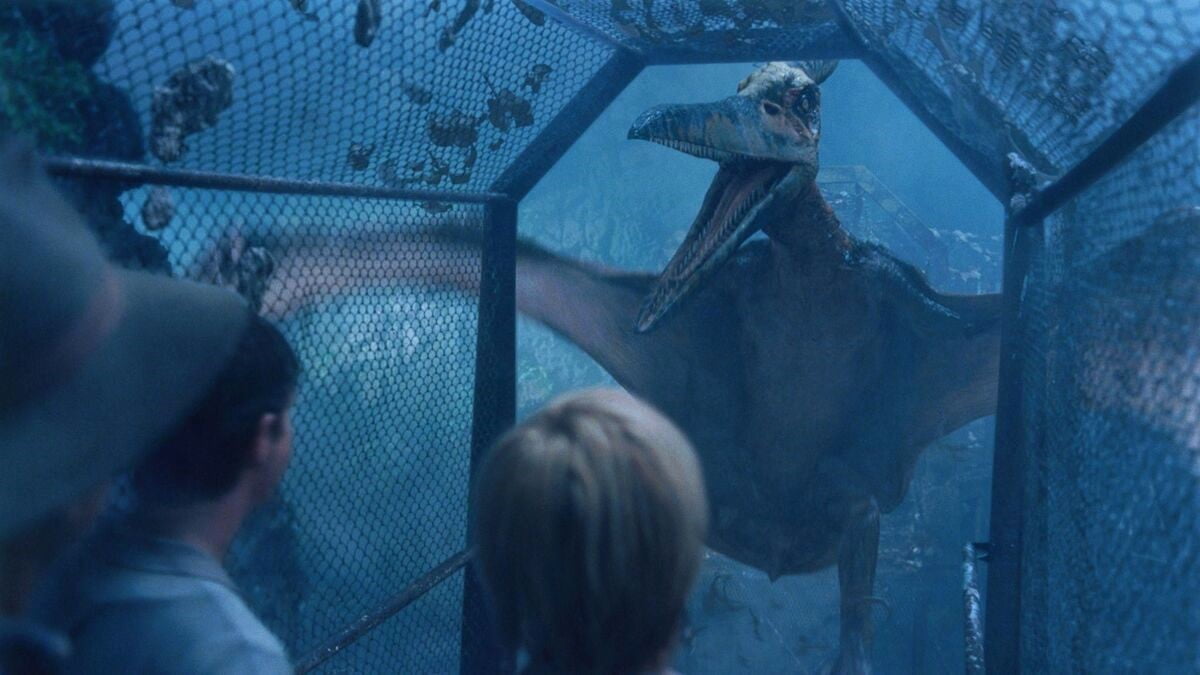The Jurassic Park 3 movie brought advanced CGI and animatronic dinosaurs of the new millennium. The story takes place four years after the events of The Lost World. The dinosaurs still inhabit the island of Isla Sorna.
Naturally, the news of wild dinosaurs goes public, an illegal tourism industry brings dinosaurs and man into conflict. While hang-gliding with a friend, Eric Kirby is stranded on Isla Sorna and his parents seek the help of Alan Grant. They trick him into returning to the island for a flyby, failing to mention that they intended to land.
They are attacked by a new top predator. Once their plane crashes they become stranded in what is perhaps the most dangerous place in the world. The team must find Eric and make it to the coast as they make their way through the jungle. Along the way, they encounter a new and terrifying predator.
Although it caused a rift in the fan community, Jurassic Park 3 was a very successful film. It would remain the final chapter in the franchise for 14 years.
While the film underwent many revisions during production, it achieved many positive things. In fact, it gave audiences an entirely new perspective of Spinosaurus. This dinosaur was relatively unknown in the public sphere before this movie; it has since become a fan favorite.
Making Jurassic Park 3
Jurassic Park 3 continued the franchise, taking audiences back to Isla Sorna. For the first time, the film was not adapted from a Michael Crichton novel. The story needed to be an exciting adventure story that took audiences to new territory.
Steven Spielberg gave the director reigns to Joe Johnston. Stan Winston Studios and Industrial Light and Magic (ILM) returned for their third act. Once again, advances in technology contributed to the level of effects the film could achieve. Rather than yield to the rapidly advancing technology of computer-generated images, the makers of the film decided that practical effects were still needed.
Now, CGI and animatronic dinosaurs could interact seamlessly on screen. The blending of various technologies contributed to the astonishing new effects. Old tools were improved and adapted to make the dinosaurs look more realistic than ever. The previous films relied more on shooting on location to achieve most of the scenes from the jungle. In Jurassic Park 3 much of the jungle footage is conducted on stage. The desired flora was brought in and with the tricks of the light, the immense jungle environment was created.
With a new movie comes the opportunity to introduce new creatures. Again, the filmmakers consulted paleontologist Jack Horner. The first two films had one undeniable top predator, the Tyrannosaurus. Horner hypothesized that Tyrannosaurus was ill-suited to being a hunter and was predominantly a scavenger.
Putting The Jurassic Park 3 Movie Together
The filmmakers wanted something new to take the place of T. rex. There were many dinosaur candidates, most notably Baryonyx, which was scrapped because it wasn’t large enough. The decision was made to incorporate Spinosaurus, currently, the largest theropod dinosaur ever known.
The urge to up the ante required thorough character development of Spinosaurus to make the audiences fear and respect the new creature. Other creatures received a makeover as well.
While the final action sequence of The Lost World Jurassic Park was intended to feature Pteranodon, the idea was scrapped in favor of a T. rex attack sequence, giving Pteranodon only seconds on screen.
Jurassic Park 3 incorporates this pterosaur by adapting a scene from the first novel. Even the iconic Velociraptor took on a new look. The incorporation of feathers on the males and a revision of the skull was intended to represent new scientific discoveries. The film achieved success at the box office and would remain the last film in the franchise for 14 years.
The Cast of Jurassic Park 3
Dr. Alan Grant

Played by: Sam Neil
Bio: Dr. Alan Grant continues to research Velociraptors and he is seeking more funding for his research. When Paul Kirby offers a substantial sum of money to have Grant act as a guide for a flyover of Isla Sorna, Grant accepts. Soon he realizes this was all a ruse and he is once again stranded with dinosaurs.
Billy Brennan

Played by: Allesandro Nivola
Bio: Billy is Dr. Grant’s good friend and his assistant in the field. The Kirby’s approach him with an offer to visit Isla Sorna and he accepts, The money will fund his research with Grant. He is very outgoing and can sometimes take great risks for his passions, risks which jeopardize the safety of the group.
Paul Kirby

Played by: William H. Macy
Bio: Paul Kirby is the concerned father of Eric Kirby. When his son is lost on Isla Sorna, Paul goes to extreme measures to get to the island. He lies to Dr. Grant and other members of a team he recruits for the rescue mission, pretending to be wealthy and writing bogus checks to get them to tag along.
Amanda Kirby

Played by: Téa Leoni
Bio: Amanda Kirby is the mother of Eric Kirby who organizes a rescue mission with her former husband Paul when no one else will help rescue their son. She plays along with Paul Kirby to gather a team to help them rescue Eric. She feels guilty about her son’s situation.
Eric Kirby
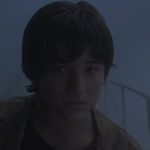
Played by: Trevor Morgan
Bio: Eric is the son of Paul and Amanda Kirby. When a para-sailing accident leaves him stranded on Isla Sorna, he manages to survive on his own for almost eight weeks. His firsthand knowledge of the dinosaurs and the island proves useful to the group.
Mr. Udeksy

Played by: Michael Jeter
Bio: Mr. Udesky is hired by Paul and Amanda Kirby to coordinate their mission. After the crash, Udesky learns that Kirby’s checks were fraudulent and he is stuck in one of the most dangerous places on earth and not even getting paid for his troubles.
M.B. Nash
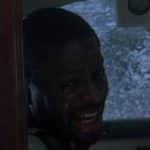
Played by: Bruce A. Young
Bio: Mr. Nash is hired by Paul and Amanda Kirby to rescue Eric from Isla Sorna. Nash serves as the pilot for the team and is forced to make a difficult decision, abandoning Cooper to save the others. He tries to fly the group to safety but ends up crashing after the attack.
Mr. Cooper
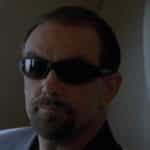
Played by: John Diehl
Bio: Cooper is hired by Paul and Amanda Kirby as a mercenary for the expedition. Mr. Udesky selected him due to his reputation. His weapons do not seem to be effective against the Spinosaurus, or at least his aim fails, and Cooper must flee like the others.
Dr. Ellie Sattler

Played by: Laura Dern
Bio: Dr. Ellie Sattler is a paleobotanist and a mother. She meets Dr. Grant at her house and he tells her about his research on Velociraptor, which she jokingly calls her “favorite.” She receives a call from Grant, who tells her that he is on Site B and needs help.
Ben Hildebrand
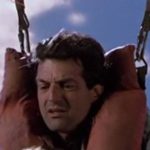
Played by: Mark Harelik
Bio: Ben Hildebrand is Amanda’s boyfriend. Ben takes Eric on a para-sailing trip, something his father Paul Kirby would never approve. He and Eric become stranded on Isla Sorna after an attack and must find their way to safety as soon as possible. Ben faces an unseen threat along the way.
Mark Degler

Played by: Taylor Nichols
Bio: Mark is Ellie’s husband in Jurassic Park 3. His government job has allowed him many opportunities for networking with foreign nations. He uses his connections to send a rescue team to the island to evacuate Dr. Grant and the other survivors.
Dinosaurs of Jurassic Park 3
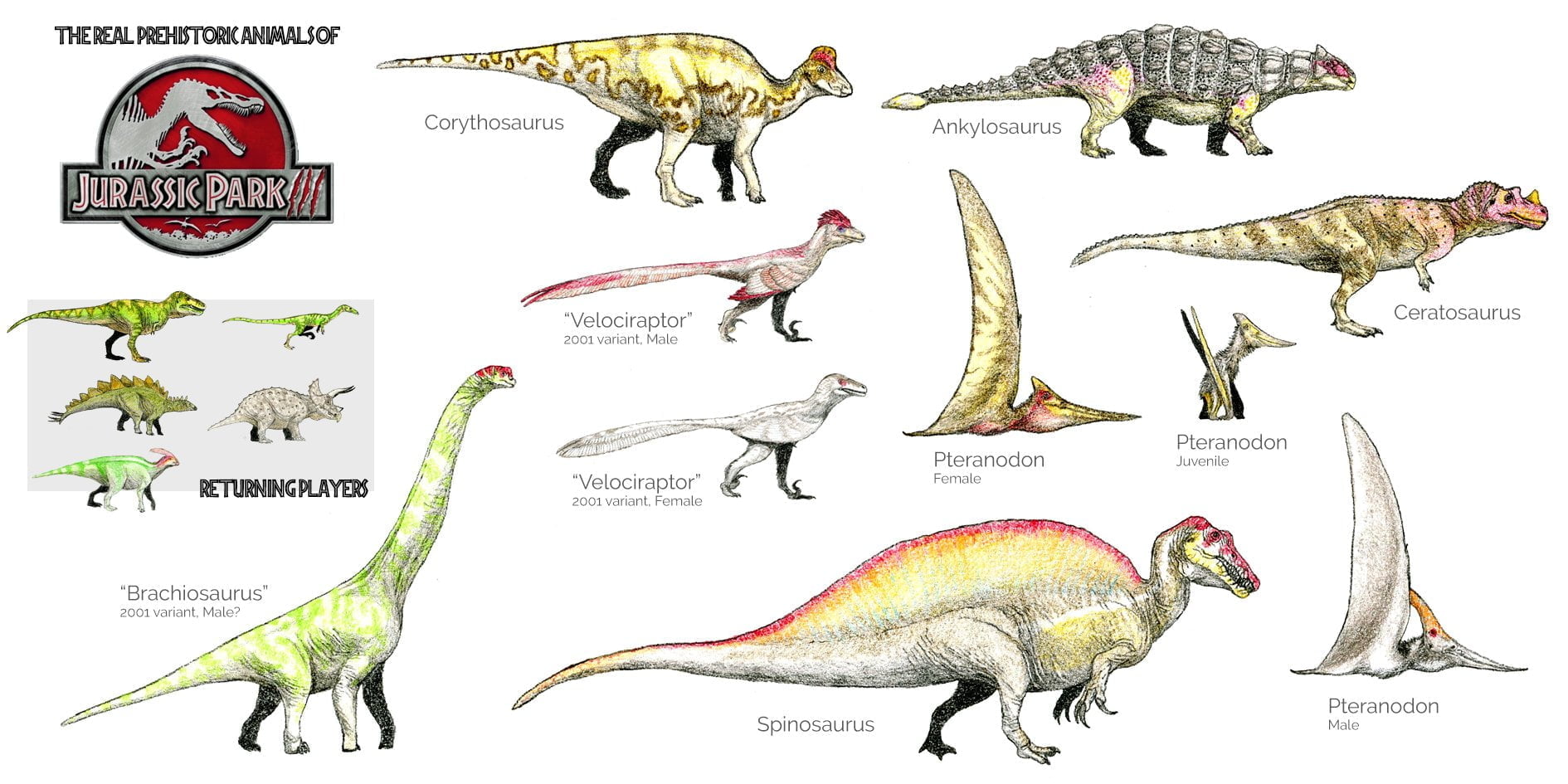
The Science of Jurassic Park 3
Spinosaurus vs. Tyrannosaurus
The thrilling battle from Jurassic Park 3 could never have happened, as millions of years and geography separated the two carnivores. Discussion over which animal would win a fight remains speculation because no one can accurately gauge the extent of an animal’s behavior from fossils. Spinosaurus is now accepted as the largest theropod dinosaur and may have been even larger than the one portrayed in the film.
Tyrannosaurus, long hailed the ultimate predatory dinosaur was indeed a very impressive animal. Tyrannosaurs had a tremendous bite force designed to crush bones. Spinosaurus is believed to have fed primarily on fish, so its jaws are long and narrow. It is important to note that Spinosaurus did share its habitat with another large predator, Carcharodontosaurus, which was also larger than Tyrannosaurus.
The two animals specialized in different food sources and rarely if ever fought over meals. Most modern predators tend to avoid territorial confrontations resulting in death, so a real battle between the two carnivores would have most likely been less violent. Spinosaurus might have used its sail as a way to look bigger to other dinosaurs just as modern animals do.
Was Velociraptor Really That Intelligent?
In Jurassic Park 3, Dr. Grant proposes that Velociraptor were capable of advanced communication and were smarter than modern primates and dolphins. No research suggests that Velociraptor was even close to the intelligent, problem-solving creature in the Jurassic Park franchise.
Studies have shown that dromeosaurs were among the smartest dinosaurs, but there is little evidence to suggest they were any smarter than modern chickens. Fossils of multiple Deinonychus together seem to indicate pack hunting, but no one is certain if this was random cooperation or an organized social structure.
Could Pteranodon Hunt Humans?
The Pteranodon portrayed in Jurassic Park 3 was inaccurate in many ways. Firstly, the name Pteranodon is Greek and translates to “winged and toothless,” whereas the animals in the film have numerous teeth. Pteranodon like other pterosaurs would have been covered in pycnofiber (pterosaur fur). Inconsistencies may stem from the fact that all these animals are hybrids, not true to their prehistoric counterparts.
Pteranodon had wings designed for gliding, and the movie takes some liberties with its patterns of flight. Pteranodon would likely feed primarily on fish, meaning that it would ignore humans altogether. Further questions arise from how these animals could survive in an aviary without food.
The aviary is located on the river, where carcasses of animals could float downstream and be scavenged by the Pteranodons. These animals are extremely lightweight for their size.
While on the topic of size, it must be noted that the Pteranodon in the films were greatly oversized and could not have lifted a human. Even the largest pterosaurs lacked clasping feet, making this feat impossible.
How Accurate was Spinosaurus?
The Spinosaurus in Jurassic Park 3 has a bad reputation for being more of a monster than an animal. While new reconstructions have changed the look of Spinosaurus, the depiction in the film was very progressive for 2001.
Spinosaurus is now believed to be the largest theropod dinosaur. The prehistoric creature may have fed primarily on fish, but without the large fish species in its habitat, this Spinosaurus may have adapted to hunt more on land.
It pursues the humans throughout the film, likely because it finds them easy prey items who venture through its territory. Many also question the addition of another large predator to an island full of predators, but Spinosaurus likely ventured into the ocean for some of its meals, possibly feeding on sharks and dolphins in addition to the dinosaurs of Isla Sorna. The fight with a T. rex was an attempt to startle audiences and show the power of the animal. This could also make sense as an attempt to reduce competition for food sources.
Could Dinosaur Dung Save Someone?
In Jurassic Park 3, the group avoids an attack from a Ceratosaurus in what is normally perceived as a comical scene. The Spinosaurus was one of the top predators on Isla Sorna, thus its scent would certainly have intimidated a smaller predator. Eric Kirby says that he recovered T.rex urine that scared off smaller dinosaurs but attracted Spinosaurus.
Scent plays a much stronger role to other members of the animal kingdom than it does to humans. Using dinosaur excrement might be a very useful tactic for survival. It remains unclear whether or not dinosaurs produced liquid urine or uric acid, as most modern birds do.
How Fast was Velociraptor?
In Jurassic Park, Robert Muldoon says that Velociraptors could run more than 50 miles per hour if they were loose. In Jurassic Park 3, we finally get to see these dinosaurs in pursuit of prey. Luckily, the group has a substantial head start on the dinosaurs.
Could the real animals run that fast? There have been numerous studies on the speed of Mesozoic animals. A 2007 paper by Sellers & Manning provides an experiment that created robotic models of animal limb bones and muscles to test in real-time the top speed at which they could get them to run. Using this method, they tested the running speeds of 5 theropods.
The results showed a top speed of 24 miles per hour for Velociraptor, 23 miles per hour for Dilophosaurus, 18 miles per hour for T. rex, and a speedy 40 miles per hour for Compsognathus. While nowhere near the 50-60 miles per hour boasted by Jurassic Park, even the relatively slow T. rex still just outpaces the average human.
Best Jurassic Park 3 Quotes
“Now what John Hammond and InGen did at Jurassic Park is create genetically engineered theme park monsters, nothing more and nothing less.” – Dr. Alan Grant
“No force on earth or heaven could get me on that island.” – Dr. Alan Grant
“Some of the worst things imaginable have been done with the best intentions.” – Dr. Alan Grant
“Okay, fine. Go ahead and scream and when that tricycloplots attacks you, don’t come crying to me.” – Paul Kirby
“I dare ’em to nest in Enid, Oklahoma.” – Amanda Kirby
“Nothing to worry about sir. It’s going to be a walk in the park.” – Mr. Udesky
“You know something, Dr. Grant? Billy was right.” – Eric Kirby
Jurassic Park 3 Trivia
The animatronic Spinosaurus weighed a whopping 12 tons, making it the largest animatronic animal ever created for a Jurassic Park film.
The Jurassic Park pinball machine can be seen in the background during the scene at the bar.
Originally, Baryonyx was intended to be the villain dinosaur of the film. This was changed to Spinosaurus due to the latter having a more distinctive appearance and much larger size.
Jurassic Park 3 was plagued by changing scripts and underwent major changes during production as major plot elements were not finalized.
The feathers on the Velociraptor were meant to reflect an updated scientific understanding of dinosaurs despite their inaccuracies compared with actual dinosaur feathers. Dinosaur feathers were more similar to modern birds and covered much more of the body.

